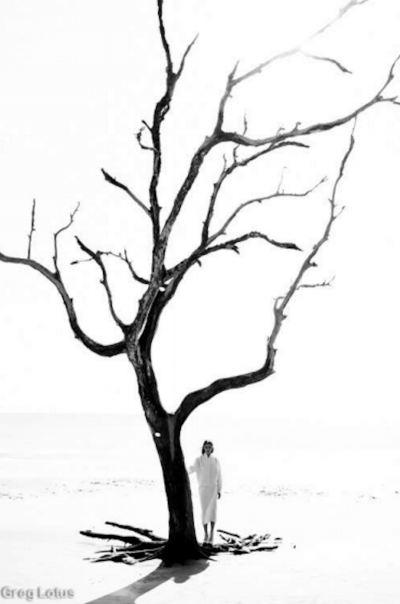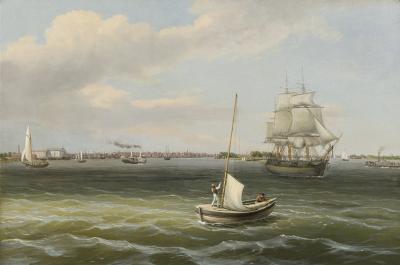Charles H. Davis
As lovely a land as any on earth.” So Frances Davis, Charles Harold Davis’ wife, described the artist’s feeling about the Connecticut landscapes he depicted in its many moods and atmospheres.
Born in Amesbury, Massachusetts, Davis lived in France for ten years in the 1880s. He returned to Amesbury and soon after settled in Mystic, Connecticut, a town and a world that initially suited his needs geographically, but quickly became “the land of his heart” as Mrs. Davis described it.
At a time in the American art marketplace when a premium seems always attached to figurative impressionism, the works of Charles Davis, pure landscape in all its glory, would seem to be of no great note. In fact, Davis’ works, when they appear, consistently capture the imagination, the inspiration, and the piece of our soul that can only respond to the light, air, and wholesome nature of the land.
Davis’ work is wonderfully consistent in its artistic integrity and quality. However, unlike many artists of his generation, or artists painting in New England and focusing on landscape, Davis was always exploring and developing his artistic goals. For a collector of art who is moved by excellence in landscape painting, Davis’ work offers myriad evocations of the changeable moods of the land.
Davis was initially deeply influenced by the works of J.F. Millet and J.C. Cazin, leading him to explore the landscapes of Barbizon in France. He established himself as a master of tonalism with major exhibition pieces at the Paris Salon throughout the 1880s. Works on a grand scale as well as more intimate views were avidly collected by museums and major collectors in Boston and New York. The Metropolitan Museum of Art and the Pennsylvania Academy of the Fine Arts each acquired breathtakingly beautiful works by Davis, works that defined his extraordinary ability as a painter of mood and light. Abandoned, a major work of this period captures the soft, mystical aspect of Davis’ painting.
Upon his return to America, and, specifically, his move to Mystic, Davis began to respond to the very different inspiration that the Connecticut landscape offered. Combined with his familiarity with the burgeoning Impressionist movement in art, the sunlight and atmosphere of New England led him to brighten his palette and vary his compositions to suit the more rugged, dramatic land.
A masterpiece by Davis, Summer Clouds, won several major awards when exhibited at the Pennsylvania Academy of the Fine Arts (1901), the Pan American Exposition in Buffalo, New York (1901), and the Universal Exposition in St. Louis (1904). With its ambitious size and dazzling effects of sunlight and shadow over the New England coast, the work beckons the viewer to walk right into the image. In a 1901 review of the Pan American Exposition, Mary Brown Hartt refers to this work: “…and best of all, Summer Clouds hung in the outer vestibule. Full of feeling for the modeled firmness of sunlit knoll and hollow, for opulent sunshine and rich shadows; for the clear brilliancy of summer seas and skies. This single canvas makes an impression of Davis’s mingled strength and subtlety not soon to be forgotten.” This painting, along with The Valley, September Afternoon, represents the essence of Davis’ realist impressionism. To be sure, his “signature” interest in clouds are a compelling aspect of his works and enhance the appeal and desirability of his paintings.
In the slightly later painting, View of the Mystic River, we see Davis using a light, though soft palette and painting in a distinctly impressionist style. Gestural brushstrokes throughout the landscape along with a spontaneous flecked handling combine to create a spirited, uplifting Connecticut view.
One of the most admirable and fascinating aspects of Davis’ life and career as a painter is his openness to change and his interest in developing his style as an artist. Though he always remained a representational painter, Davis sought new techniques and styles throughout his career from his deeply moving tonalism of the 1880s, to his Connecticut impressionism, to, late in his career, his exploration of aspects of modernism and abstraction.
Clearing Off and the little gem Evening Rose are delightful examples of how Davis’ brushwork was evolving in the early 1900s. The geometric brushstrokes and subtle abstraction of the clouds, trees, and landscape in Clearing Off is a refreshing, daring, and successful stylistic change that energizes the scene and the artwork itself.
Evening Rose is a thoroughly delightful work on a wonderfully intimate scale. It captures that very fleeting moment in the evening when the sun, as it sets, turns the clouds to a glorious rose color. That Davis could bring that evanescent moment to us in such an effective way is his great genius as a plein-airist.
Charles Davis and his work are a wonderful example of the kind of artist and the kind of work that offers a rare opportunity in the art marketplace. The exceptional integrity of the man, his art, and his whole career are comparable to the most important painters of his day. Arguably a “regional” painter as a result of his passion for the Connecticut landscapes near his home in Mystic, and his longevity there, he was, in fact, a worldly and widely exhibited artist throughout his life. While he was never particularly tempted to stray much beyond nature as a subject, he was as fine a painter of nature and the land as the early 20th-century produced.
The prices for his work range from $5,000 to $200,000, in a time when some of his colleagues’ work will command 10 times that much. For a collector of American art of the turn of the century, Davis’ evocative and poetic paintings of the American landscape offer everything one could seek: great value, consistent quality, variety, and, most importantly, beauty beyond compare.
For further reading, I would enthusiastically recommend Thomas Colville’s marvelous article “Charles H. Davis: Painter of Poetic Moods” from The Magazine Antiques (November 1995) and also Mr. Colville’s essays in Charles Harold Davis, NA, 1856-1933, a monograph published by the Mystic Art Association, Inc., in 1982.
All illustrations are courtesy of The Cooley Gallery, 25 Lyme Street, Old Lyme, CT 06371. The Cooley Gallery specializes in Fine American Paintings and Works on Paper of the 19th and 20th Centuries including Hudson River School, Impressionism, and Select Contemporary Realism. The gallery can be reached by phone at 860.434.8807; or visit their website www.cooleygallery.com.















.jpg)
.jpg)
.jpg)
.jpg)
.jpg)
















